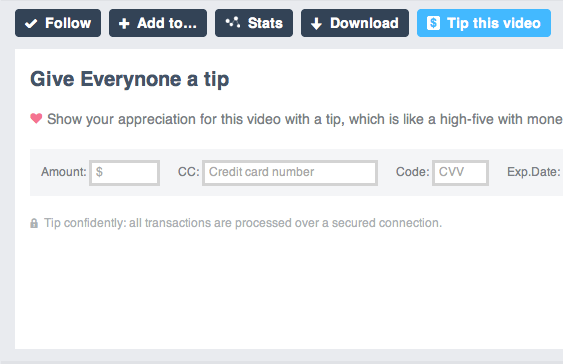Vimeo is a great site that’s done a lot for independent online video creation and publishing, but one thing that’s been missing from its platform is a way for creators to make money directly from their movies. The video network now offers that, thanks to a new Tip Jar feature rolling out today. It allows Vimeo Plus or Pro members to add tip buttons to any video content, so that users can click and easily donate between $0.99 and $500. In tandem with a new pay-to-view service announced today but rolling out over the next several months, Vimeo wants to offer creators a way to develop complex, custom-fit revenue strategies.
The idea is to provide a complement for completed works to what Kickstarter offers in the planning and pre-production phase – something that harnesses the instincts of crowdfunding while also enabling continued patronage after a movie is made. Tip Jar is somewhat reminiscent of similar efforts by early creative web pioneers to use things like the PayPal Donate button to monetize, but unlike that solution, it’s incredibly easy to set up, and for viewers, donating is a simple process of entering credit card info in the same window where the movie plays.
In an interview, Vimeo President Dae Mellencamp explained that Vimeo’s intent has always been to give its community members a way to make money via their work, and that this seemed like the right moment, and the right way to do so.
“Tip Jar allows users of a video that has it enabled to tip [the video] before during or after playback,” she said. “We’re calling it ‘crowdsourced revenue’ for completed works, which we think is sort of the easiest way to understand it. When you think of the growth of crowdsourced funding and how successful that’s been on the production front, it makes a lot of sense.”
Kickstarter and other crowdfunding sites have definitely helped boost interest in creator-owned independent video content. The Film & Video category is responsible for over $73 million of Kickstarter’s total successful funding money, the largest category by far, and is second only to music in terms of current live projects, according to current stats. Vimeo looking to build on that success makes sense not only for its creators, but also for the network itself, as the company will collect 15 percent of any tips that come in, passing on 85 percent to artists. Mellencamp admits that that could represent a new revenue path for Vimeo, but also says it’s too early to tell at this stage in the game whether it’ll be have a significant impact overall for Vimeo itself.
The second part of Vimeo’s new monetization options is essentially a pay wall, but one that’s very much left open to creators to decide how to implement. The pay-to-view features will be available to Vimeo Pro subscribers when it launches across the site in 2013, but the network is planning a staged rollout with select partners before then. Mellencamp says users will be able to mix and match pay-to-view with Tip Jar, in order to, for example, keep one episode in a series free and offer the rest behind a pay wall, or give a limited release free of charge for early adopters and potential evangelists before charging for content later. Vimeo will provide detailed analytics via their admin panel, as well as in the form of cumulative periodic wrap-up reports to provide a bird’s-eye view of performance overall, so that creators can adjust their strategies, get feedback and see what works best.
Vimeo’s path to monetization differs considerably from what YouTube provides its creators, which is still basically a cut of ad revenue. Mellencamp said that’s because Vimeo first wants to cultivate a different kind of content, and keep the focus on content first without viewer annoyances like pre-roll or on-content ads, and also because the ultimate aim is to provide all of its creators with a way to gain a sizable revenue stream, something which the Tip Jar/pay wall approach might accomplish better for those with small but passionate followings than ad revenue share based on views or impressions.
One key element of Vimeo’s new monetization element will be how quickly the network can bring them to its premiere partner platforms, including the Apple TV and smart TVs (it already works wherever Vimeo is viewable in a browser). Mellencamp says that making Tip Jar “as broadly available as possible” is a key goal for the network, however, and the web still represents the bulk of its traffic.
I think this is a significant change in Vimeo’s overall model and approach, and the company is clearly doing its best to minimize impact on user experience. The Tip Jar is innocuous enough, and I see no reason it won’t gain wide adoption if it actually results in conversions. How the introduction of opt-in, completely creator-controlled pay walls affects the network will be another question entirely and could result in a more fundamental change of the nature of Vimeo, one that the introduction of the pilot projects coming soon should give us an interesting early peek at.
